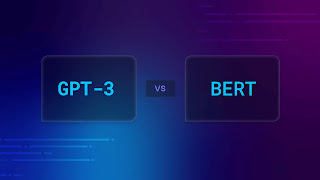Introdution
Natural Language Processing (NLP) has come a long way in the past few years, with two giants dominating the landscape: OpenAI’s GPT-4 and Google’s BERT.Explore a full comparison between GPT-4 and BERT. Discover which NLP model is better for developers in 2026 for performance, cost, and flexibility.
GPT-4 vs BERT:
As of 2026, these models are essential tools for developers building AI apps, chatbots, translation engines, search tools, and much more.
But which one is better for your project? Whether you prioritize cost, speed, accuracy, or fine-tuning capabilities, this post gives you a full breakdown of GPT-4 vs BERT — from a developer’s perspective.
⚙️ What Are GPT-4 and BERT?
GPT-4 (Generative Pre-trained Transformer 4)
-
Developed by OpenAI
-
Autoregressive language model
-
Capable of generating human-like text, code, and more
-
Trained with hundreds of billions of parameters
-
Used in chatbots, AI agents, content creation, code generation
BERT (Bidirectional Encoder Representations from Transformers)
-
Developed by Google AI
-
Bidirectional transformer model
-
Best at understanding context and semantics in text
-
Primarily used for classification, search engines, and question answering
-
Fine-tuned on domain-specific tasks (e.g., BioBERT, LegalBERT)
🧪 Key Technical Differences
| Feature | GPT-4 | BERT |
|---|---|---|
| Model Type | Autoregressive Transformer | Bidirectional Transformer |
| Training Approach | Next-word prediction | Masked Language Modeling (MLM) |
| Output Style | Text generation | Text understanding |
| Size | ~1T parameters (multi-modal) | Base: 110M / Large: 340M params |
| Fine-tuning | Few-shot / zero-shot supported | Requires task-specific fine-tuning |
| API Cost | Higher ($$$) | Lower ($) |
| Use Case Flexibility | Extremely high | Medium to high |
📌 Use Case Comparison: Which Model Wins?
🔍 Search & Context Understanding
Winner: BERT
-
BERT is deeply trained to understand context, making it perfect for search engines and question answering systems.
-
Google still uses BERT in its core search algorithm due to its accuracy in semantic understanding.
✍️ Text Generation & Chatbots
Winner: GPT-4
-
GPT-4 generates long, coherent, human-like text.
-
Used in AI writing tools, virtual assistants, story creation, and even code.
⚖️ Performance vs Cost
Winner: Depends on the budget
-
GPT-4 is more powerful but also significantly more expensive.
-
BERT is lighter, faster, and cost-efficient for smaller tasks or on-device inference.
🧠 Learning Efficiency
Winner: GPT-4 (Few-shot Learning)
-
GPT-4 performs tasks without extensive retraining, thanks to its massive pretraining and contextual awareness.
-
BERT often needs fine-tuning for each task, especially in custom domains.
💡 When to Use GPT-4
Use GPT-4 if you need:
-
Natural and human-like text generation
-
Multi-modal support (text + images)
-
AI agents or autonomous workflows
-
Language translation or summarization
-
Code generation (e.g., Python, JS)
Example Projects:
-
AI Chatbots
-
Content generators
-
Interactive tutors
-
AI coding assistants
💡 When to Use BERT
Use BERT if your focus is:
-
Text classification
-
Sentiment analysis
-
Search result ranking
-
Named entity recognition
-
Question answering
Example Projects:
-
Smart search for e-commerce
-
Customer support classification tools
-
SEO/semantic analyzers
-
Medical/Legal NLP systems
🧑💻 Developer Tips for 2026
GPT-4 Tips:
-
Use OpenAI’s API with caching to reduce costs
-
Apply prompt engineering to fine-tune responses
-
Explore Open Source alternatives like Mistral or Mixtral for lighter tasks
BERT Tips:
-
Use distilled versions like DistilBERT for speed
-
Fine-tune on domain-specific datasets for max performance
-
Consider BERT variants like SciBERT or FinBERT for specialized industries
📌 Summary: Which NLP Model Is Best for Developers?
| Need | Best Model |
|---|---|
| Text generation & dialogue | GPT-4 |
| Semantic understanding | BERT |
| Cost-efficient deployments | BERT |
| Multi-tasking & versatility | GPT-4 |
| On-device or edge AI | BERT (distilled) |
| Few-shot or zero-shot learning | GPT-4 |
Verdict:
-
Choose GPT-4 for creative, generative, and multi-functional applications.
-
Choose BERT for classification, intent detection, and search-based systems.
🧠 Final Thoughts
GPT-4 and BERT serve different strengths in the NLP world. While GPT-4 dominates in conversational AI and creativity, BERT remains the go-to model for deep text understanding and cost-effective deployments.
The best model for you depends on your project goals, budget, and technical needs. In 2026, developers are increasingly combining both models to build hybrid NLP systems that are smart, scalable, and user-friendly.
🔁 Related Posts
-
TensorFlow vs PyTorch: Which is Best for Your AI Project in 2026?
-
The Best GPUs for AI Development in 2026
-
AI Predictions for 2026: What Experts Are Saying
-
How AI is Transforming Fraud Detection in Banking Today
